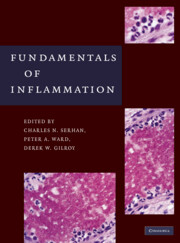Book contents
- Frontmatter
- Contents
- Contributors
- Preface
- PART I THE INFLAMMATORY RESPONSE – AN OVERVIEW
- 1 Acute and Chronic Inflammation
- 2 Resolution of Acute Inflammation and Wound Healing
- 3 Links between Innate and Adaptive Immunity
- PART II INDIVIDUAL CELL TYPES
- PART III CHEMICAL MEDIATORS
- PART IV IMMUNOPHARMACOLOGY
- PART V INFLAMMATORY DISEASES/HISTOLOGY
- PART VI ANIMAL MODELS OF INFLAMMATION
- Index
- References
2 - Resolution of Acute Inflammation and Wound Healing
from PART I - THE INFLAMMATORY RESPONSE – AN OVERVIEW
Published online by Cambridge University Press: 05 April 2014
- Frontmatter
- Contents
- Contributors
- Preface
- PART I THE INFLAMMATORY RESPONSE – AN OVERVIEW
- 1 Acute and Chronic Inflammation
- 2 Resolution of Acute Inflammation and Wound Healing
- 3 Links between Innate and Adaptive Immunity
- PART II INDIVIDUAL CELL TYPES
- PART III CHEMICAL MEDIATORS
- PART IV IMMUNOPHARMACOLOGY
- PART V INFLAMMATORY DISEASES/HISTOLOGY
- PART VI ANIMAL MODELS OF INFLAMMATION
- Index
- References
Summary
SUMMARY
It is without doubt that resolution of acute inflammation is under strict checkpoint control by endogenous proresolution factors. It is these factors and mechanisms inherent in resolution that are crucial in preventing excessive tissue injury, autoimmunity, and chronic inflammation. In this chapter, resolution and the factors that control it are detailed to underline its importance in human pathology and highlight new and more effective treatment modalities with fewer side effects for chronic inflammatory diseases.
INFLAMMATION IN HEALTH AND DISEASE
Inflammation is a beneficial host response to foreign challenge or tissue injury that leads ultimately to the restoration of tissue structure and function. It is a reaction of the microcirculation that is characterized by the movement of serum proteins and leukocytes from the blood to the extravascular tissue. This movement is regulated by the sequential release of vasoactive and chemotactic mediators, which contribute to the cardinal signs of inflammation – heat, redness, swelling, pain, and loss of tissue function (Figure 2.1A). Local vasodilation increases regional blood flow to the inflamed area and, together with an increase in microvascular permeability, results in the loss of fluid and plasma proteins into the tissues. Concomitantly, there is an upregulation of adhesion molecule expression on endothelial cells and the release of chemotactic factors from the inflamed site, which facilitate the adherence of circulating cells to the vascular endothelium and their migration into the affected area.
- Type
- Chapter
- Information
- Fundamentals of Inflammation , pp. 17 - 27Publisher: Cambridge University PressPrint publication year: 2010
References
- 2
- Cited by



